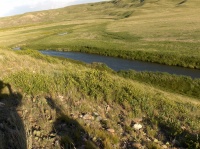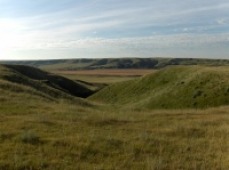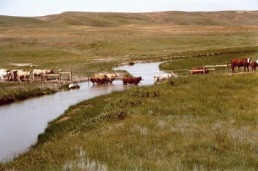Objective
My research forms part of
a larger program designed to quantify the environmental benefits
of agricultural best management practices in use on cattle ranches in
Southern Alberta. The basic research question this course project
attempts to address is:
Can reductions in E. coli
concentrations be seen in water quality measured at the farm-scale when
we fence cattle out of a stream?
Figure 1. Regional landscape surrounding the project
site, Mixed grass natural subregion, Alberta.
Figure 2. Cattle use of riparian pastures and
streams, Lower Little Bow River, Alberta.
Summary

Ranchers are being asked
to change a variety of practices to reduce their environmental impacts
and the protection of riparian areas is one best management practice
(BMP) that seems to make sense. Cattle impacts to streams are
visible, so removing cattle should improve water quality by removing
those impacts. Numerous studies have shown watershed-scale
benefits to the use of such practices, and smaller scale studies across
the United States have shown improvments to agricultural stream water
quality, but is this the case in Southern Alberta?
Water quality
response to the installation of a riparian fencing treatment was
monitored with weekly and biweekly water quality samples collected from
2004 to 2007. An 800m stream reach within a cattle pasture served
as the experimental treatment and was fenced on both banks to prevent
cattle access to the channel. An upstream channel reach of equal
length was used as a control treatment and provided background water
quality of the stream channel against which water quality of the
treatment area could be compared. Samples were only collected on
one stream; no replicates of the treatment were used.
E.coli
concentrations collected between June and November were compared across
years between treatment and control samples using annual means and
weekly differences. Data was normalized by a log transformation
of E.coli concentration and transformed data was compared
between fenced and unfenced treatments in each year
using Welch's t test with unequal variance. The
resulting p values (p>0.05) failed to support the
rejection of the null hypothesis (a=0.05), suggesting that there may be
no treatment effect of fencing on E.coli concentration; however, major
flaws in the experimental design limit this conclusion.
Website created by: JL Scott, AScT, BSc jlscott@ualberta.ca
Note:
This website was created as a course project for RenR 480, Department
of Renewable Resources, University of Alberta.
Data used is modified or randomly generated.



